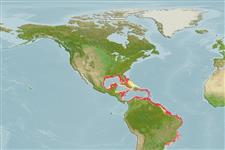Common names from other countries
Environment: milieu / climate zone / depth range / distribution range
экология
морской демерсальный; пределы глубины 20 - 150 m (Ref. 5217). Subtropical; 30°N - 26°S, 98°W - 34°W
Western Atlantic: northwestern Gulf of Mexico to Brazil.
Size / Вес / Возраст
Maturity: Lm ? range ? - ? cm
Max length : 32.0 cm TL самец/пол неопределен; (Ref. 5217); common length : 25.0 cm TL самец/пол неопределен; (Ref. 3275); наибольший вес (опубликованные данные): 371.30 g (Ref. 128822)
колючие лучи спинного плавника (общее число) : 0; членистые (мягкие) лучи спинного плавника (общее число) : 82 - 90; колючие лучи анального плавника: 0; членистые (мягкие) лучи анального плавника: 63 - 69. Body is oval, moderately elongate. Dorsal fin originates distinctly anterior to a vertical at front of the eyes. Eyes on left side, not large, their diameter is 5 - 5.9 times the head length. The interorbital space is narrow, less than half the eye diameter. Lateral line on eyed side is not steeply arched above pectoral fin. The mouth is large extending slightly beyond the posterior margin of the eyes. Caudal fin is rounded. Color is brown with a large blotch beneath pectoral fin. The dorsal and anal fins have a row of dark spots containing pale areas,. Two spots on the dorsal and a few on the anal are large. The caudal fin has three large dark spots at the posterior border, none on center of the fin. Number of ovaries: 2. Ovaries are symmetrical, lie parallel with each other, depressed cross-sectionally and extra-visceral in location (Ref. 101557).
Occurs in bays, lagoons and shallow coastal waters. Found on soft bottoms (Ref. 5217). Marketed fresh (Ref. 5217).
Life cycle and mating behavior
Maturities | размножение | Spawnings | Egg(s) | Fecundities | личинки
Distinct pairing (Ref. 205). Number of ovaries: 2. Ovaries are symmetrical, lie parallel with each other, depressed cross-sectionally and extra-visceral in location (Ref. 101557).
Robins, C.R. and G.C. Ray, 1986. A field guide to Atlantic coast fishes of North America. Houghton Mifflin Company, Boston, U.S.A. 354 p. (Ref. 7251)
Статус Красного Списка МСОП (Ref. 130435)
CITES (Ref. 128078)
Not Evaluated
Угроза для людей
Harmless
Использование человеком
рыболовство: не имеет хозяйственного значения
дополнительная информация
инструменты
Специальные отчеты
Скачать в формате XML
ресурсы в Интернет
Estimates based on models
Preferred temperature (Ref.
115969): 19.6 - 27.4, mean 24.8 (based on 192 cells).
Phylogenetic diversity index (Ref.
82804): PD
50 = 0.5625 [Uniqueness, from 0.5 = low to 2.0 = high].
Bayesian length-weight: a=0.00891 (0.00405 - 0.01963), b=3.11 (2.93 - 3.29), in cm Total Length, based on LWR estimates for this (Sub)family-body shape (Ref.
93245).
Trophic level (Ref.
69278): 3.6 ±0.2 se; based on size and trophs of closest relatives
устойчивость к внешним воздействиям (Ref.
120179): высокий, минимальное время удвоения популяции до 15 месяцев (K=0.78).
Fishing Vulnerability (Ref.
59153): Low vulnerability (20 of 100).
